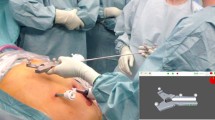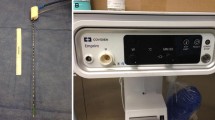Abstract
Purpose
To evaluate and compare the needle placement accuracy, patient dose, procedural time, complication rate and ablation success of microwave thermoablation using a novel robotic guidance approach and a manual approach.
Methods
We performed a retrospective single-center evaluation of 64 microwave thermoablations of liver tumors in 46 patients (10 female, 36 male, mean age 66 years) between June 2014 and February 2015. Thirty ablations were carried out with manual guidance, while 34 ablations were performed using robotic guidance. A 6-week follow-up (ultrasound, computed tomography and MRI) was performed on all patients.
Results
The total procedure time and dose-length product were significantly reduced under robotic guidance (18.3 vs. 21.7 min, \(p<0.001\); 2216 vs. 2881 mGy\(\times \)cm, \(p = 0.04\)). The position of the percutaneous needle was more accurate using robotic guidance (needle deviation 1.6 vs. 3.3 mm, \(p< 0.001\)). There was no significant difference between both groups regarding the complication rate and the ablation success.
Conclusion
Robotic assistance for liver tumor ablation reduces patient dose and allows for fast positioning of the microwave applicator with high accuracy. The complication rate and ablation success of percutaneous microwave thermoablation of malignant liver tumors using either CT fluoroscopy or robotic guidance for needle positioning showed no significant differences in the 6-week follow-up.



Similar content being viewed by others
References
Lubner MG, Brace CL, Hinshaw JL, Lee FT Jr (2010) Microwave tumor ablation: mechanism of action, clinical results, and devices. J Vasc Interv Radiol JVIR 21(8 Suppl):S192–S203. doi:10.1016/j.jvir.2010.04.007
Shibata T, Niinobu T, Ogata N, Takami M (2000) Microwave coagulation therapy for multiple hepatic metastases from colorectal carcinoma. Cancer 89(2):276–284
Tanaka K, Shimada H, Nagano Y, Endo I, Sekido H, Togo S (2006) Outcome after hepatic resection versus combined resection and microwave ablation for multiple bilobar colorectal metastases to the liver. Surgery 139(2):263–273. doi:10.1016/j.surg.2005.07.036
Kurumi Y, Tani T, Naka S, Shiomi H, Shimizu T, Abe H, Endo Y, Morikawa S (2007) MR-guided microwave ablation for malignancies. Int J Clin Oncol 12(2):85–93. doi:10.1007/s10147-006-0653-7
Kuang M, Lu MD, Xie XY, Xu HX, Mo LQ, Liu GJ, Xu ZF, Zheng YL, Liang JY (2007) Liver cancer: increased microwave delivery to ablation zone with cooled-shaft antenna-experimental and clinical studies. Radiology 242(3):914–924. doi:10.1148/radiol.2423052028
Shimada S, Hirota M, Beppu T, Matsuda T, Hayashi N, Tashima S, Takai E, Yamaguchi K, Inoue K, Ogawa M (1998) Complications and management of microwave coagulation therapy for primary and metastatic liver tumors. Surg Today 28(11):1130–1137
Kloeckner R, dos Santos DP, Schneider J, Kara L, Dueber C, Pitton MB (2013) Radiation exposure in CT-guided interventions. Eur J Radiol 82(12):2253–2257. doi:10.1016/j.ejrad.2013.08.035
Rathmann N, Haeusler U, Diezler P, Weiss C, Kostrzewa M, Sadick M, Schoenberg SO, Diehl SJ (2014) Evaluation of radiation exposure of medical staff during CT-guided interventions. J Am Coll Radiol JACR. doi:10.1016/j.jacr.2014.04.012
Kato R, Katada K, Anno H, Suzuki S, Ida Y, Koga S (1996) Radiation dosimetry at CT fluoroscopy: physician’s hand dose and development of needle holders. Radiology 201(2):576–578. doi:10.1148/radiology.201.2.8888264
Solomon SB, Patriciu A, Bohlman ME, Kavoussi LR, Stoianovici D (2002) Robotically driven interventions: a method of using CT fluoroscopy without radiation exposure to the physician. Radiology 225(1):277–282. doi:10.1148/radiol.2251011133
Mbalisike EC, Vogl TJ, Zangos S, Eichler K, Balakrishnan P, Paul J (2014) Image-guided microwave thermoablation of hepatic tumours using novel robotic guidance: an early experience. Eur Radiol. doi:10.1007/s00330-014-3398-0
Abdullah BJ, Yeong CH, Goh KL, Yoong BK, Ho GF, Yim CC, Kulkarni A (2015) Robotic-assisted thermal ablation of liver tumours. Eur Radiol 25(1):246–257. doi:10.1007/s00330-014-3391-7
Omary RA, Bettmann MA, Cardella JF, Bakal CW, Schwartzberg MS, Sacks D, Rholl KS, Meranze SG, Lewis CA (2003) Quality improvement guidelines for the reporting and archiving of interventional radiology procedures. J Vasc Interv Radiol JVIR 14(9 Pt 2):S293–S295
Prosch H, Stadler A, Schilling M, Burklin S, Eisenhuber E, Schober E, Mostbeck G (2012) CT fluoroscopy-guided vs. multislice CT biopsy mode-guided lung biopsies: accuracy, complications and radiation dose. Eur J Radiol 81(5):1029–1033. doi:10.1016/j.ejrad.2011.01.064
Elias D, Di Pietroantonio D, Gachot B, Menegon P, Hakime A, De Baere T (2006) Liver abscess after radiofrequency ablation of tumors in patients with a biliary tract procedure. Gastroenterol Clin Biol 30(6–7):823–827
Author information
Authors and Affiliations
Corresponding author
Ethics declarations
Conflict of interest
None.
Ethical standard
All procedures performed in studies involving human participants were in accordance with the ethical standards of the institutional and/or national research committee and with the 1964 Helsinki declaration and its later amendments or comparable ethical standards.
Informed consent
This study was evaluated retrospectively. For this type of study formal consent and institutional review board approval is not required by our hospital.
Rights and permissions
About this article
Cite this article
Beyer, L.P., Pregler, B., Niessen, C. et al. Robot-assisted microwave thermoablation of liver tumors: a single-center experience. Int J CARS 11, 253–259 (2016). https://doi.org/10.1007/s11548-015-1286-y
Received:
Accepted:
Published:
Issue Date:
DOI: https://doi.org/10.1007/s11548-015-1286-y




